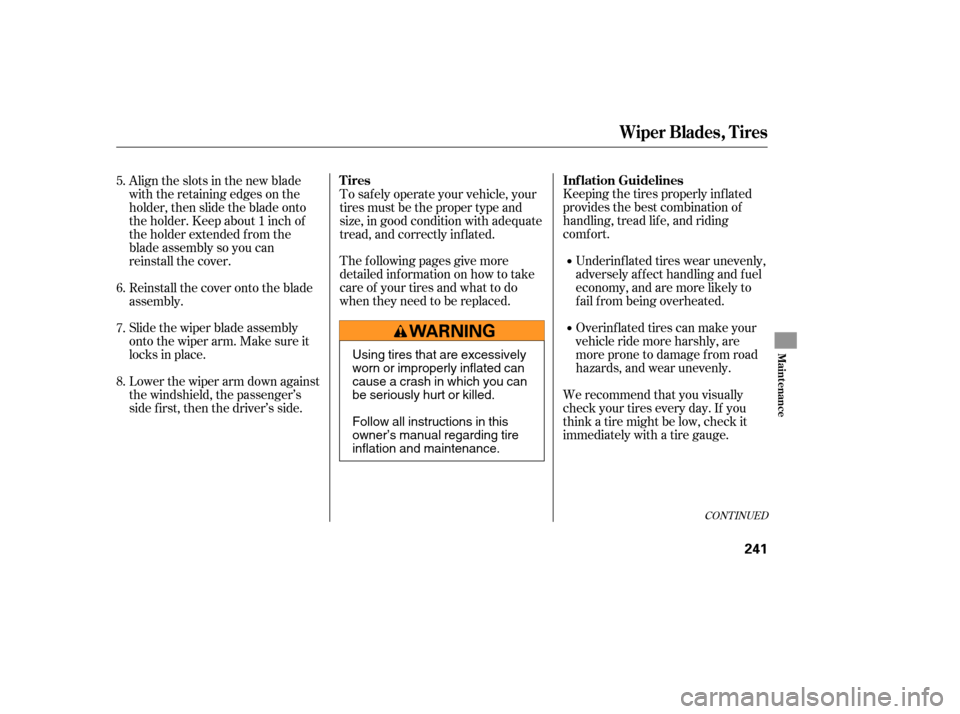Page 245 of 307

Keeping the tires properly inf lated
provides the best combination of
handling, tread lif e, and riding
comf ort.Underinf lated tires wear unevenly,
adversely affect handling and fuel
economy, and are more likely to
fail from being overheated.
Overinf lated tires can make your
vehicleridemoreharshly,are
more prone to damage f rom road
hazards, and wear unevenly.
We recommend that you visually
check your tires every day. If you
think a tire might be low, check it
immediately with a tire gauge.
To saf ely operate your vehicle, your
tires must be the proper type and
size, in good condition with adequate
tread, and correctly inf lated.
The f ollowing pages give more
detailed inf ormation on how to take
care of your tires and what to do
when they need to be replaced.
Align the slots in the new blade
with the retaining edges on the
holder, then slide the blade onto
the holder. Keep about 1 inch of
the holder extended f rom the
blade assembly so you can
reinstall the cover.
Reinstall the cover onto the blade
assembly.
Slide the wiper blade assembly
onto the wiper arm. Make sure it
locks in place.
Lower the wiper arm down against
the windshield, the passenger’s
side first, then the driver’s side.
5.
6.
7.
8.
CONT INUED
Inf lation Guidelines
Tires
Wiper Blades, Tires
Maint enance
241
Using tires that are excessively
worn or improperly inflated can
cause a crash in which you can
be seriously hurt or killed.
Follow all instructions in this
owner’s manual regarding tire
inflation and maintenance.
�����—�����—�����y�
����
�
������y���
�(�+���������y���������y
Page 255 of 307

This section covers the more
common problems that motorists
experience with their vehicles. It
gives you inf ormation about how to
safely evaluate the problem and what
to do to correct it. If the problem has
stranded you on the side of the road,
you may be able to get going again.
If not, you will also f ind instructions
on getting your vehicle towed.......................
Compact Spare Tire .252
....................
Changing a Flat Tire .253
.............
If the Engine Won’t Start .257
................................
Jump Starting .259
..............
If the Engine Overheats .261
.........
Low Oil Pressure Indicator .263
..........
Charging System Indicator .263
.......
Malf unction Indicator Lamp .264
...............
Brake System Indicator .265
..............................................
Fuses .266
..............................
Fuse Locations .270
......................
Emergency Towing .272
Taking Care of the Unexpected
T aking Care of t he Unexpect ed
251
�����—�����—�����y�
����
��������y���
�(�+���������y���������y
Page 257 of 307

CONT INUED
If you have a f lat tire while driving,
stop in a saf e place to change it.
Drive slowly along the shoulder until
you get to an exit or an area that is
far away from the traffic lanes.
Thesizedifferencemayalsocause
damage to the dif f erential, so do not
mount the compact spare on the
f ront. If either f ront tire goes f lat,
removethereartireonthatsame
side, mount the compact spare tire
on the rear, then mount the rear tire
on the f ront.Turn on the hazard warning lights,
and turn the ignition switch to the
LOCK (0) position. Have all
passengers get out of the vehicle
while you change the tire. Park the vehicle on f irm, level, and
non-slippery ground. Put the
transmission in Park (automatic)
or reverse (manual). Apply the
parking brake.Open the trunk. Raise the trunk
f loor by lif ting up on the back edge.
Unscrew the wing bolt, and take
the spare tire out of its well. Take the tool kit case out of the
trunk.
Thecompactsparetireissmaller
than a standard tire, and it will affect
the vehicle’s handling. Drive
cautiously when the spare is
mounted on your vehicle.
5. 4.
3.
2. 1.
On Si model only
Changing a Flat Tire
T aking Care of t he Unexpect ed
253
SPARE TIRE
TRUNK FLOOR JACK TOOL CASE
The vehicle can easily roll off
the jack, seriously injuring
anyone underneath.
Follow the directions for
changing a tire exactly, and
never get under the vehicle
when it is supported only by the
jack.
�����—�����—�����y�
����
����
���y���
�(�+���������y���������y
Page 258 of 307
Loosen each wheel nut 1/2 turn
with the wheel nut wrench.Place the jack under the jacking
point nearest the tire you need to
change. Turn the end bracket
clockwise until the top of the jack
contacts the jacking point. Make
sure the jacking point tab is
restinginthejacknotch.Use the extension and the wheel
nut wrench as shown to raise the
vehicle until the f lat tire is of f the
ground.
Remove the wheel nuts, then
remove the f lat tire. Handle the
wheel nuts caref ully; they may be
hot from driving. Place the flat tire
on the ground with the outside
surface facing up.
6. 7. 8.
9.
Changing a Flat Tire
254
WHEEL NUT WRENCHJACKING POINTS
EXTENSION
WHEEL NUT WRENCH
�����—�����—�����y�
����
��������y���
�(�+���������y���������y
Page 259 of 307
CONT INUED
Do not attempt to forcibly pry the
wheel cover of f with a screwdriver
or other tool. The wheel cover
cannot be removed without f irst
removing the wheel nuts.Bef ore mounting the spare tire,
wipeanydirtoff themounting
surface of the wheel and hub with
a clean cloth. Wipe the hub
carefully;itmaybehotfrom
driving.Put on the spare tire. Put the
wheel nuts back on f inger-tight,
then tighten them in a crisscross
pattern with the wheel nut wrench
until the wheel is f irmly against
the hub. Do not try to tighten
them f ully.
Lower the vehicle to the ground,
and remove the jack.
11.
10.
12.
Changing a Flat Tire
T aking Care of t he Unexpect ed
255
WHEEL NUTS WHEEL COVER BRAKE HUB
WHEEL NUTS
�����—�����—�����y�
����
��������y���
�(�+���������y���������y
DX, Canadian DX-G , and LX models
Page 260 of 307
Remove the center cap from the
flat tire.Place the flat tire face down in the
spare tire well.
Remove the spacer cone f rom the
wing bolt, turn it over, and put it
back on the bolt.
Secure the f lat tire by screwing
the wing bolt back into its hole.
Tighten the wheel nuts securely in
the same crisscross pattern. Have
the wheel nut torque checked at
the nearest automotive service
f acility.
Tighten the wheel nuts to:
14.
15.
13.
16.
17.
Changing a Flat Tire
256
WING BOLT
SPACER CONE
For
compact
spare tireFor normal
tire
80 lbf·ft (108 N·m , 11 kgf·m)
�����—�����—�����y�
����
��������y���
�(�+���������y���������y
OnEXandSimodelsintheU.S.,and
LX, EX, andSi models in Canada
Page 261 of 307

When you turn the ignition switch to
the START (III) position, you do not
hear the normal noise of the engine
trying to start. You may hear a
clicking sound or series of clicks, or
nothing at all.
Check these things:Check the transmission interlock.
If you have a manual transmission,
the clutch pedal must be pushed
all the way to the f loor or the
starter will not operate. With an
automatic transmission, it must be
in Park or neutral.
Diagnosing why the engine won’t
start f alls into two areas, depending
on what you hear when you turn the
ignition switch to the START (III)
position:
You hear nothing, or almost
nothing. The engine’s starter
motor does not operate at all, or
operates very slowly.
You can hear the starter motor
operating normally, or the starter
motor sounds like it is spinning
f aster than normal, but the engine
does not start up and run.
Store the jack and tools in the tool
kit case. Place the tool kit case in
the center of the flat tire.
Store the wheel cover or center
cap in the trunk. Make sure it does
not get scratched or damaged.
Lower the trunk f loor, then close
the trunk lid.
Turn the ignition switch to the ON
(II) position. Turn on the
headlights, and check their
brightness. If the headlights are
very dim or do not come on at all,
the battery is discharged. See
on page .259
18.
19.
20.
CONT INUED
Nothing Happens or the Starter
Motor Operates Very Slowly
If the Engine Won’t Start
Jump Starting
Changing a Flat Tire, If the Engine Won’t Start
T aking Care of t he Unexpect ed
257
Loose items can fly around the
interior in a crash and could
seriously injure the occupants.
Store the wheel, jack, and tools
securely before driving.
�����—�����—�����y�
����
��������y���
�(�+���������y���������y
Page 276 of 307

�µ�µ If , due to damage, your vehicle must
be towed with the f ront wheels on
the ground, do this:
If your vehicle needs to be towed,
call a prof essional towing service or
organization. Never tow your vehicle
with just a rope or chain. It is very
dangerous.
Therearetwowaystotowyour
vehicle:
The operator
loads your vehicle on the back of a
truck.
The tow
truck uses two pivoting arms that go
under the f ront tires and lif t them of f
the ground. The rear tires remain on
the ground. Release the parking brake.
Shif t the transmission to neutral.
Turn of f the engine. ShifttoD,thentoN.
Start the engine.
Release the parking brake. Leave the ignition switch in the
ACCESSORY (I) position so the
steering wheel does not lock.
Leave the ignition switch in the
ACCESSORY (I) position so the
steering wheel does not lock.
Do not tie down the vehicle at an
angle that would allow the towing
cables to contact the vehicle’s f ront
bumper. To avoid possible damage,
protect the f ront bumper with tape. With the f ront wheels on the ground,
do not tow the vehicle more than 50
miles (80 km), and keep the speed
below35mph(55km/h).
If your vehicle is equipped with a
f ront spoiler, remove it bef ore
towing so it is not damaged.
Manual Transmission:
Automatic Transmission:
Flat -bed Equipment
Wheel-lif t Equipment
This is the best way to trans-
port your vehicle.
This is an acceptable
way to tow your vehicle.
Emergency Towing
272
Improper towing preparation will
damage the transmission. Follow the
above procedure exactly. If you cannot
shif t the transmission or start the
engine (automatic transmission), your
vehicle must be transported with the
f ront wheels of f the ground.
�����—�����—�����y�
����
��������y���
�(�+���������y���������y